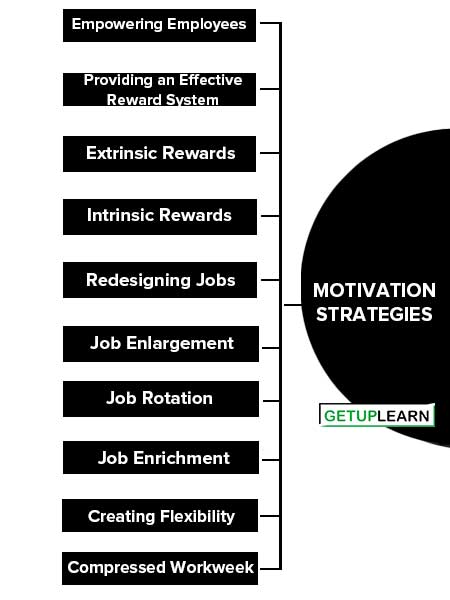Table of Contents
Motivation Strategies
To some extent, a high level of employee motivation is derived from effective management practices. To develop motivated salesmen, a sales manager must treat people as individuals, empower them, provide an effective reward system, redesign jobs, and create a flexible workplace. The following are the motivation strategies:
- Empowering Employees
- Providing an Effective Reward System
- Extrinsic Rewards
- Intrinsic Rewards
- Redesigning Jobs
- Job Enlargement
- Job Rotation
- Job Enrichment
- Creating Flexibility
- Compressed Workweek
- Telecommuting

Empowering Employees
Empowerment occurs when individuals in an organization are given autonomy, authority, trust, and encouragement to accomplish a task. Empowerment is designed to unshackle the employee and to make a job the employee’s responsibility.
In an attempt to empower and change some of the old bureaucratic ideas, managers are promoting corporate intrapreneurship. Intrapreneurship encourages employees to pursue new ideas and gives them the authority to promote those ideas. Obviously, intrapreneurship is not for the timid, because old structures and processes are turned upside down.
Providing an Effective Reward System
Managers often use rewards to reinforce employee behavior that they want to continue. A reward is a work outcome of positive value to the individual. Organizations are rich in rewards for people whose performance accomplishments help meet organizational objectives. People receive rewards in one of the following two ways:
Extrinsic Rewards
Extrinsic rewards are externally administered. They are valued outcomes given to someone by another person, typically a supervisor or higher-level manager.
Common workplace examples are pay bonuses, promotions, time off, special assignments, office fixtures, awards, verbal praise, and so on. In all cases, the motivational stimulus of extrinsic rewards originates outside the individual.
Intrinsic Rewards
Intrinsic rewards are self-administered. Think of the “natural high” a person may experience after completing a job.
That person feels good because he has a feeling of competency, personal development, and self-control over his work. In contrast to extrinsic rewards, the motivational stimulus of intrinsic rewards is internal and doesn’t depend on the actions of other people.
Redesigning Jobs
Many people go to work every day and go through the same, unenthusiastic actions to perform their jobs. These individuals often refer to this condition as burnout. But smart managers can do something to improve this condition before an employee becomes bored and loses motivation.
The concept of job redesign, which requires knowledge of and concern for the human qualities people bring with them to the organization, applies motivational theories to the structure of work for improving productivity and satisfaction.
When redesigning jobs, managers look at both job scope and job depth. Redesign attempts may include the following:
Job Enlargement
Often referred to as horizontal job loading, job enlargement increases the variety of tasks a job includes. Although it doesn’t increase the quality or the challenge of those tasks, job enlargement may reduce some of the monotony, and as an employee’s boredom decreases, his or her work quality generally increases.
Job Rotation
This practice assigns people to different jobs or tasks to different people on a temporary basis. The idea is to add variety and to expose people to the dependence that one job has on other jobs.
Job rotation can encourage higher levels of contribution and renew interest and enthusiasm. The organization benefits from a cross-trained workforce.
Job Enrichment
Also called vertical job loading, this application includes not only an increased variety of tasks but also provides an employee with more responsibility and authority. If the skills required to do the job are skills that match the jobholder’s abilities, job enrichment may improve morale and performance.
Creating Flexibility
Today’s employees value personal time. Because of family needs, a traditional nine-to-five workday may not work for many people. Therefore, flexi-time, which permits employees to set and control their own work hours, is one way that organizations are accommodating their employees’ needs. Here are some other options organizations are trying as well:
Compressed Workweek
A compressed workweek is a form of flextime that allows a full-time job to be completed in less than the standard 40-hour, five-day workweek. Its most common form is the 4/40 schedule, which gives employees three days off each week.
This schedule benefits the individual through more leisure time and lower commuting costs. The organization should benefit through lower absenteeism and improved performance. Of course, the danger in this type of scheduling is the possibility of increased fatigue.
Telecommuting
Telecommuting, sometimes called flex place, is a work arrangement that allows at least a portion of scheduled work hours to be completed outside of the office, with work-at-home as one of the options. Telecommuting frees the jobholder from needing to work fixed hours, wearing special work attire, enduring the normal constraints of commuting, and having direct contact with supervisors.
Home workers often demonstrate increased productivity, report fewer distractions, enjoy the freedom to be their own boss, and appreciate the benefit of having more time for themselves.
Of course, when there are positives, there are also negatives. Many home workers feel that they work too much and are isolated from their family and friends. In addition to the feelings of isolation, many employees feel that the lack of visibility at the office may result in the loss of promotions.
FAQs About the Motivation Strategies
What are the motivation strategies?
These are the motivation strategies given below:
1. Empowering Employees
2. Providing an Effective Reward System
3. Extrinsic Rewards
4. Intrinsic Rewards
5. Redesigning Jobs
6. Job Enlargement
7. Job Rotation
8. Job Enrichment
9. Creating Flexibility
10. Compressed Workweek.
